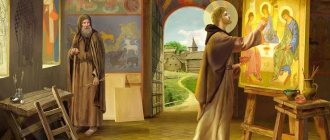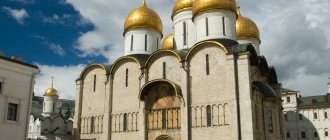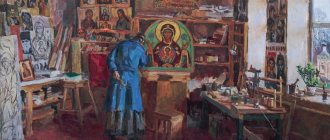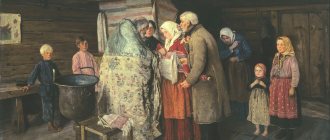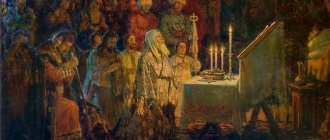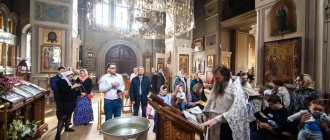Among the Old Believers-bezpopovtsy, the Sacrament of Baptism is performed both in natural reservoirs and in the font. If baptism takes place in a font, then the water must be changed after each person being baptized - it is unacceptable to immerse two people being baptized in the same water, since the sins of the person being previously baptized remain in this font. The rites of the sacrament of baptism are strictly observed, however, due to historical circumstances, only those sections of consumer books that were intended for the laity in the absence of a priest are implemented in practical life:
Our Small Potnik, even in a priestless time, was compiled quickly, but not without the Conciliar Reason for the Great Potnik, and only the priestly prayers were shortened, and additional questions were placed in confession. (Answer from spiritual mentor Fr. Vladimir Shamarin to spiritual mentor Fr. Alexander Khrychev about the rite of the Sacrament of Baptism)
Priestlessism has never rejected any church sacrament or ritual as an idea, nor has it questioned the status of the priesthood as the bearer of God's grace. Due to the fact that, according to the teachings of the priestless Old Believers, after the schism of the 17th century, the apostolic succession of the Orthodox clergy was interrupted, the grace of the priesthood was interrupted, and the church hierarchy ceased, the problem of receiving the rank of converts turned out to be one of the primary and very difficult. Old Believer non-priest thinkers in the 18th century explained in their writings that in the current historical situation it is impossible, due to the absence of the Old Orthodox church hierarchy, to preserve “the unchanging completeness of all external forms of the Church’s existence,” and therefore partial retreats are inevitable, as evidenced by examples from the Old and New Testament, from the writings of the Holy Fathers and the history of the Church:
Those who needlessly dare to do wrong, as if they were criminals of the law, are condemned. Out of necessity, the one who dares is not exactly condemned, but is also worthy of praise and honor and is justified by all teachers. Otherwise, there is flight and reasoning in this, as in such there is a similarity to daring, in which the most extreme need commands, but not when this is adjacent to the need offering, and not necessary times, and to the need that is not subject to mystery, the need for action, we begin to produce.
Orthodox canons allow a layman to baptize and rebaptize, that is, to receive “from heresies coming” in the first rite. Among the Old Believers without priests (except for the Spasovites), it is customary for all those who wish to convert from official Orthodoxy to the Old Believers to undergo rebaptism . There is also a practice of re-baptism when moving into the community of Old Believers from other interpretations and agreements. The Vygovites, justifying the rebaptism, wrote that in general every heretic is subject to re-baptism, and if the church has not previously rebaptized some heretics, then this should be understood not as a law, but as “condescension” in the hope of their speedy conversion. Reception according to the second and third orders, in the absence of the priesthood, is impossible.
Old Believer of Pomeranian consent. Engraving, 1794
Regarding the reception of priests who received “Nikonian” baptism, the non-priest ideologists initially did not have a common opinion. It is known that the dispute about the rebaptism of the priests in the 1710s took place among the Starodub Pomeranians . the Kerzhen forests who arrived in Starodubye Pomeranian mentor Spiridon Ivanov raised objections . His message to Kerzhenets has been preserved, justifying the inadmissibility of rebaptizing the priests. However, soon all the non-priests (again, except for the Spasovites) made it a rule to rebaptize the priests who came over to them.
In the first half of the 18th century, in the Pomeranian and Fedoseyev agreements, the principles of rite reception were established, based on Orthodox rules that apply not to heretics, but to sinners. The reception of Fedoseevites by the Pomeranians and vice versa was carried out through a special prayer rule - the beginning of repentance . The Polish Fedoseyevsky Council in 1751 somewhat tightened the requirements for the Pomeranians moving into the Fedoseyevsky consent, establishing that, in addition to the beginning, they must bow to 300 times.
The first Filippov mentors received neophytes coming from the Pomeranian and Fedoseevsky concords in different ways. Monk Philip himself and his disciple Monk Matthew continued to use the principle of repentance to receive converts. Philip's student, monk Terenty , spoke in favor of applying a more stringent rule, establishing that converting non-priests must undergo a six-week fast.
Popovtsy and non-popovtsy
The schism in the Russian Orthodox Church in the 1650-60s, associated with the reforms of Patriarch Nikon, put adherents of the old rite in a difficult situation - there was not a single bishop in their ranks. The last was Pavel Kolomensky, who died in 1656 and left no successors.
According to the canons, the Orthodox Church cannot exist without a bishop, because only he is authorized to appoint priests and deacons. When the last pre-reform priests and deacons passed away, the Old Believers parted ways. One part of the Old Believers decided that they could resort to the help of priests who had renounced Nikon’s faith. They began to willingly accept priests who had left their diocesan bishop. This is how the “priests” appeared.
Another part of the Old Believers was convinced that after the Schism, grace completely left the Orthodox Church and all that was left for them was to humbly await the Last Judgment. The Old Believers who rejected the priesthood began to be called “bespopovtsy.” They settled mainly on the uninhabited shores of the White Sea, in Karelia, and the Nizhny Novgorod lands. It is among the Bespopovites that the most radical Old Believer agreements and rumors subsequently appear.
Appearance
The appearance of the Old Believers is very different from the Orthodox. This manifests itself as follows:
- Men should have big beards. Shaving them is strictly prohibited;
- The standard men's suit is a large, casual, unbuttoned shirt, as it was worn in Ancient Rus';
- The shirt is complemented by a narrow belt. He receives the function of dividing the body into a higher part - spiritual, directed towards the Creator - and a lower part, symbolizing everything earthly and low;
- No bright colors in clothes! Only raw, monochrome things;
- A tie is an unacceptable accessory for an Old Believer. It is associated with Judas, which is why the tie is called the Judas knot;
- An Orthodox woman can come to church with a scarf tied in a knot. In the Old Believer Church, a woman is only allowed to wear a headscarf, which is fastened under the chin.
This is what Old Believers usually look like.
Waiting for the Apocalypse
Eschatological motives became a key element in the ideology of the Old Believers. Many rumors of Old Believers, protecting themselves from the “anti-Christ power”, existed from generation to generation in anticipation of the imminent end of the world. The most radical movements even tried to bring it closer. In preparation for the last days, they dug caves, lay down in coffins, starved to death, threw themselves into the pool, and burned themselves with entire families and communities.
Throughout its history, the Old Believers exterminated tens of thousands of their adherents. Alexander Prugavin, an expert on Old Believers and sectarianism, tried to determine the number of schismatics who died in the fire. According to his calculations, about 10,000 people were burned alive just before 1772.
Netovtsy (Spasovo consent)
This is one of the biggest non-priest agreements. The total number of Netovites at the end of the 20th century reached 100 thousand people, mainly living in the Saratov, Nizhny Novgorod, Vladimir regions, as well as in the Middle Volga region.
Netovites (the word speaks for itself) deny Orthodox shrines, rituals and many sacraments, trust exclusively in the Savior, who “himself knows how to save us poor people.” Throughout their existence, they tried to avoid any contact with the Orthodox Church, especially if it concerned burial rites. The dead were buried in the forest, ravine or behind the fence of the cemetery.
The Netovites still did not reject the sacrament of baptism. They recognize it as possible to perform the rite of baptism in the Orthodox Church, interpreting this in a very unique way: “although it was a heretic who baptized, but a priest in robes, and not a simple peasant.” However, more strict movements make do with self-baptism, and some replace this rite by simply putting a cross on a newborn.
Spassovo's consent requires from his followers quite severe asceticism in everyday life. For example, the consumption of foods made with yeast or with hops is prohibited; they also do not eat potatoes. There is a taboo on bright and colorful clothes. The proverb says: “Whoever wears a motley shirt means his soul is the sister of the Antichrist,” or “What is not a speck of color is a servant of an imp.”
Suicide in the form of self-immolations was widespread among Netovites.
Can an Old Believer be godfather to an Orthodox Christian?
A man is about to baptize his child, and he wants to find a good and reliable friend to be his godfather. Everything would be fine, but they have a fundamental difference in worldview: one is Orthodox, the other is an Old Believer. How to resolve this situation?
This option is only possible in one case. The second godfather must be Orthodox, and the Old Believer godfather must promise not to interfere in any way with the child’s upbringing in accordance with the traditions of the current Orthodox canons.
Dyrniks
This is one of the most radical branches of salvation, which does not recognize any spiritual mentors. They do not venerate “newly painted” icons because without the priesthood there is no one to sanctify them, and “oldly painted” icons because they were desecrated by the possession of heretics. Dyrniks do not have special places of worship. Prayer takes place either outdoors or indoors through a special opening facing east. It is a sin for them to pray through a window or wall. A small group of hole makers now live in Central Siberia.
Pomeranian consent
The history of Pomeranian consent dates back to 1694, when a men's community was founded on the Vyg River. In 1723, the Vygov monastery became famous for compiling the “Pomeranian Answers”. This polemical book subsequently became an apologetic basis for the defense of the entire Old Believers.
The Pomeranians demand from their followers a complete break with the official church, and everyone who comes to them from Orthodoxy is required to rebaptize. The sacraments are not abandoned, but they are divided into those necessary for salvation (baptism, repentance and communion) and the rest, which can be dispensed with.
Serious disagreements arose among the Pomeranians over marriage. Over time, practicality triumphed. Thanks to the introduction of the marriage order, the Pomeranians legalized marital relations, which led to the possibility of legal transfer of property by inheritance.
In Soviet times, Pomeranians were the most numerous among the non-priest consents. Today large groups of their followers live in Vilnius, Riga and Moscow.
Fedoseevtsy
At the end of the 18th century, as a result of disputes about the inscription on the cross and about marriage, the Fedoseevites separated from the Pomeranian consent. In 1781, Ilya Kovylin (former serf of Prince Golitsyn) founded a community in Moscow in the area of the Preobrazhenskoye cemetery. The Fedoseyevskaya community was distinguished by strict discipline and unconditional submission to the mentor. Its members were required to observe celibacy and chastity.
Like many other Bespopovites, Fedoseevites believe that there is no more grace in the world. “We regard all modern state power as satanic, as a trap of the Antichrist,” they say. Of the church sacraments, only baptism and the Eucharist, which are performed by the laity, have been preserved. Due to non-recognition of the Orthodox priesthood, Fedoseevites practice cohabitation without marriage.
During the Great Patriotic War, a large number of Fedoseevites collaborated with the German authorities and actively opposed the Red Army and partisans.
The most numerous groups of Fedoseevites live in the Pskov, Novgorod, Ulyanovsk and Tyumen regions. Their total number is about 200 thousand people.
Customs of the Old Believers
The customs of the Old Believers were as follows.
Money amulet “Venetian magnet”
The personal patron of prosperity and wealth has already helped thousands of people get rich: ⭐ 98% of the owners have improved their financial well-being.
⭐ 3543 owners of the amulet opened their own business. ⭐ More than 5,000 people bought luxury homes or cars. To learn more
Priests' baptism
Old Believers can perform the sacrament of baptism, if desired, in a natural body of water or in a font. This sacrament must be administered by a priest. The exception is when a person dies and is afraid not to be baptized, and an Old Believer priest cannot be found nearby. The ritual is then performed by lay people.
A person is immersed in clean water three times. During the first ablution, the priest says: “The servant of God... is baptized in the name of the Father, amen, on the second,” and of the Son, amen, “on the third,” and by the Holy Spirit. , Amen." Washing in water symbolizes cleansing from sinfulness and unity with God.
Prayers should be said for the baptism and naming of the child. This is done so that the mother’s health improves after childbirth, and the child can live according to his conscience and deserve the Kingdom of Heaven. Baptism must occur on the eighth day.
Baptism among the non-priests
Among the Old Believers of Epiphany, the sacrament of baptism is performed in a similar way. Baptism is permitted both in a natural body of water and in a font.
Important: the water in the font must be changed after each baptism so that no sins remain. If an adult is baptizing, only he and the priest can be in the room with the font; in the case of an infant, relatives.
There are three baths, during which the priest pronounces a blessing. Within 8 days after baptism, it is not recommended to completely wash the body and remove the shirt in which the child was baptized. On the eighth day the anointing occurs.
Wedding
The ritual of the old rite clearly differs from that accepted in modern orthodoxy. The table shows the difference.
| Old rite | New rite | |
| Reading the Apostle and the Gospel. | At first | After applying the crowns |
| Singing Psalm 127. | Choirs have been added that were not present in the ancient rite. | |
| Questions for newlyweds about the voluntariness of their intentions. | No | Yes |
| Registration at the Civil Registry Office | After the wedding ceremony | Before the wedding ceremony |
| Wedding veil on the bride's head | Wear after engagement | Not used |
Marriage ceremony of an Old Believer couple.
Funeral
Old Believers have a custom of burying the dead on the 3rd day. Memorial services are held the day before the funeral, the morning of the same day, and before the funeral. The longer the memorial service lasts, the purer the soul will be before God. Only those who led honorable and righteous lives deserve a memorial service.
The head of the deceased in the coffin should be turned to the west, legs to the east. The last mass, Litia, is celebrated at the funeral. The symbols of faith are then removed from the coffin, nailed down and lowered to the ground. Old Believers do not hold a memorial service immediately after a funeral. They are carried out on days 3, 9 and 40 after death.
Pastukhovo consent
It originated in the depths of the Pomeranian consent; its founder was the shepherd Vasily Stepanov. Unlike the Pomeranians, the shepherds avoided all communication with civil authorities. They rejected money, passports and other items with the image of the state emblem. But in order to avoid debauchery they were forced to recognize the marriage.
The extreme degree of rejection of the outside world imposed on the shepherds a ban on living in settlements where there was at least one government employee, a supporter of the Orthodox Church or a representative of another Old Believer persuasion. Their feet never set foot on stone pavements, like the inventions of the “age of Antichrist.”
How Old Believers pray
It is known that Old Believers prefer to baptize themselves, like their ancestors, that is, with two fingers. After the Nikon reforms, the two-fingered sign was replaced by a three-fingered sign, symbolizing the Holy Trinity: God the Father, God the Son and God the Holy Spirit. Old Believers believe in One God the Creator and do not attribute divine attributes to the mortal Jesus and, in their opinion, the Holy Spirit, invented by Christians. The larger of the two fingers symbolizes God, and the smaller one symbolizes Jesus of Nazareth, God's prophet.
The Old Believer folds his fingers into the double finger sign.
During the service of the Old Believers, worship can only be earthly; bowing on the knees is prohibited. Earthen arches are divided into 4 types:
- ordinary - to the chest or to the navel;
- Middle - to the waist;
- “Throwing (from the Greek Metanoia - repentance) - a small earthly bow;
- Proskynesis - a big bow to the ground, kissing feet.
Runners
In 1772, in the village of Sopelki near Yaroslavl, a running movement arose as a movement opposing the “Antichrist power.” The basis of the runners’ teaching is salvation from the Antichrist, whom, unlike most Bespopovites, they perceived not as a spiritual phenomenon, but as a personified person in the guise of Peter I.
The runners live in anticipation of the “first resurrection” when Christ will fight the Antichrist. And “then the thousand-year reign of Christ will begin, the New Jerusalem for the dwelling of pilgrims will be lowered from heaven to a place where there is no sea.” The runners see their new abode near the Caspian Sea, where they regularly make pilgrimages.
All runners are “self-baptized” and undertake to lead a chaste life, eating only lean food. They completely reject marriage, but at the same time they allow fornication, considering it a lesser sin.
Popular rumor tells of a strange custom among runners called the “Red Death.” Its essence is to suffocate a dying person with a red pillow so that by martyrdom he atones not only for his sins, but also for the sins of his brothers in faith.
For centuries, the runners, persecuted by the authorities as a “harmful sect,” remained a small group scattered throughout the remote places of Siberia and the Northern Urals.
Vozdykhantsy
In 1870, in Kaluga, shoemaker Ivan Akhlebinin founded a community that later received the name Vozdykhantsev. Members of this persuasion reject any external worship of God, icons, sacraments and church hierarchy, but recognize the “explanatory books” - the Gospel, the Acts of the Apostles and the Psalter.
According to the beliefs of the Vozdykhans, first there was the kingdom of God the Father, then came the kingdom of God the Son, and after 8 thousand years from the creation of the world came the kingdom of the Holy Spirit. This doctrine was reflected in the rituals of the Vozdykhans. At prayer meetings, instead of making the sign of the cross, they sigh, raising their eyes to heaven and running a hand or handkerchief over their face.
Many other radical agreements and interpretations of the non-priest Old Believers, without significantly differing from each other, have only their own characteristics. Thus, the followers of the consent of the gapes, having gathered for prayer on the day of the Eucharist, stand with their mouths open in anticipation of being given communion by the angels.
Darkers are those who recognize the rite of baptism, but perform it only at night, as if imitating Christ.
In Akulinovo consent, community life and celibacy are accepted. This served as a repeated reason for accusing Akulino members of debauchery and sin.
The Kapitonovites of the Kshara charter are supporters of radical approaches to suicide for faith, participants in mass acts of self-immolation.
Ryabinovites believe that the cross of Christ consisted of cypress, cedar and pine tree. They associate the last tree with rowan, from which the cross should be made.
Customs of the Old Believers
Prayers in the traditional sense of the word do not exist among Old Believers. In their opinion, prayer is humiliating for both parties: the one who prays and the one to whom he prays. Instead, the Old Believers conduct their own clan rituals, but not only a layman, but even a member of another clan cannot know about them. Each clan has its own unique habits, which people keep secret.
The Old Believers have a similar attitude towards icons - they consider them idolatry. The walls of their houses are decorated not with icons, but with photographs of their ancestors, their letters and personal belongings. In this way, the strongest spiritual connection between generations is preserved, which for the Old Believers is the basis of their worldview. It's like a feeling of belonging to nature.
Old Believers identify themselves with nature, but do not worship it as God.
In general, the Old Believers do not have general strict rules and dogmas that must be strictly adhered to. It is not necessary to wear special clothes or attend ceremonies. For Old Believers, the most important thing is to live according to your conscience, in accordance with it.

